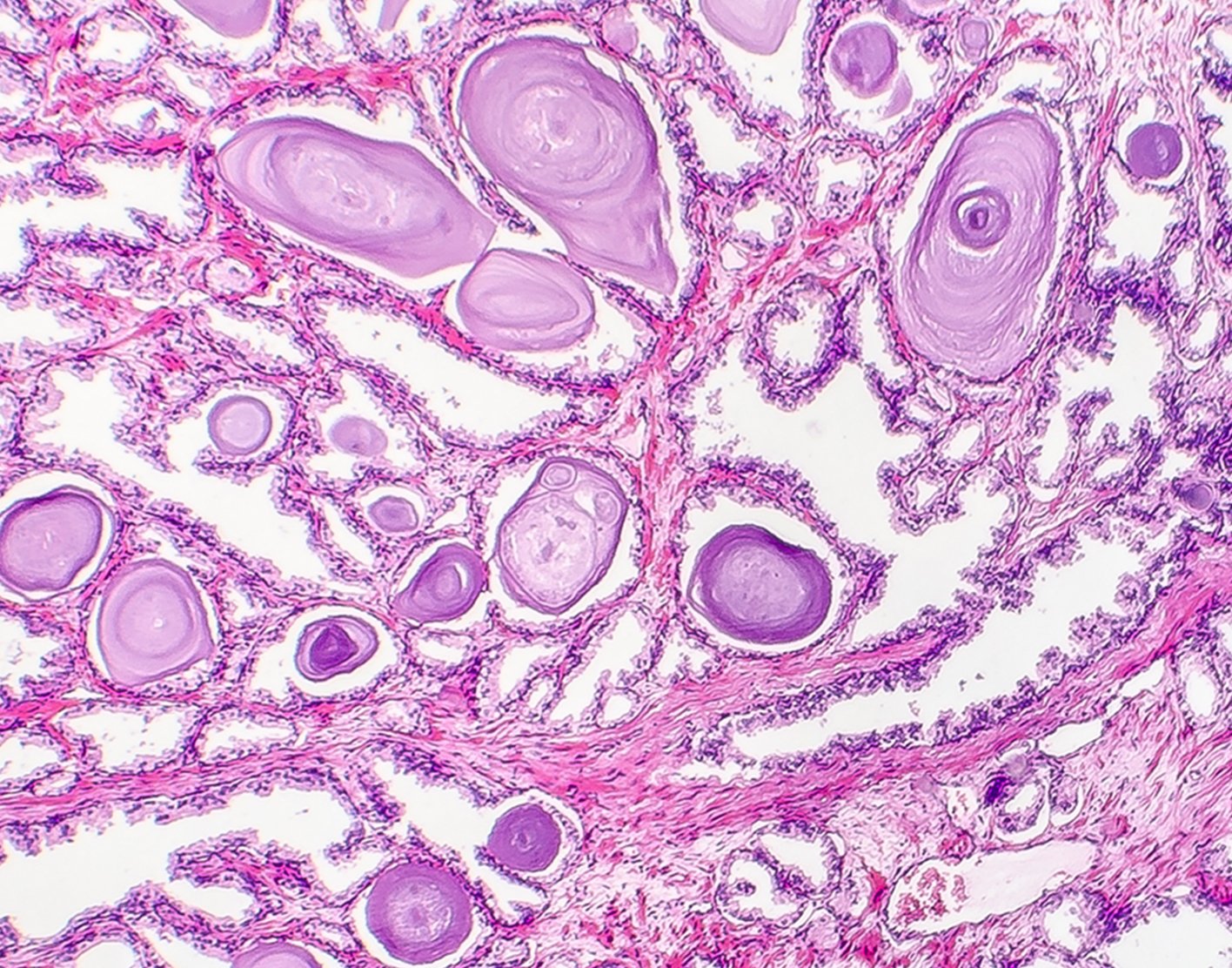
Prostate biopsy
Definition
A prostate biopsy is the removal of tiny samples of prostate tissue to examine it for signs of prostate cancer.
The prostate is a small, walnut-sized gland just under the bladder in men. It wraps around the urethra, the tube that carries urine out of the body. The prostate makes semen, the fluid that carries sperm.
Alternative Names
Prostate gland biopsy; Transrectal prostate biopsy; Fine needle biopsy of the prostate; Core biopsy of the prostate; Targeted prostate biopsy; Prostate biopsy - transrectal ultrasound (TRUS); Stereotactic transperineal prostate biopsy (STPB)
How the Test is Performed
There are three main ways to perform a prostate biopsy.
Transrectal -- through the rectum. This is the most common method.
- You will be asked to lie still on your side with your knees bent.
- Your health care provider will insert a finger-sized ultrasound probe into your rectum. You may feel a little discomfort or pressure.
- The ultrasound allows your provider to see images of the prostate. Using these images, your provider will inject a numbing medicine around the prostate.
- Then, using ultrasound to guide the biopsy needle, your provider will insert the needle into the prostate to take a sample. This may cause a brief stinging sensation.
- About 10 to 18 samples will be taken. They will be sent to the lab for examination.
- The entire procedure will take about 10 minutes.
Transperineal -- through the perineum (the skin between the anus and the scrotum), is being used more frequently.
- You will receive medicine to make you sleepy so you do not feel pain.
- Your provider will insert an ultrasound probe into your rectum to image the prostate.
- A needle is inserted into the perineum to collect prostate tissue.
A transperineal biopsy may reduce the risk of infection while maintaining similar cancer detection.
Transurethral -- through the urethra, not used very often.
- You will receive medicine to make you sleepy so you do not feel pain.
- A flexible tube with a camera on the end (
cystoscope ) is inserted through the opening of the urethra at the tip of the penis. - Tissue samples are gathered from the prostate through the scope.
How to Prepare for the Test
Your provider will inform you about the risks and benefits of the biopsy. You may have to sign a consent form.
Several days before the biopsy, your provider may tell you to stop taking any:
- Blood thinning medicines (anticoagulants) such as warfarin, (Coumadin, Jantoven), clopidogrel (Plavix), apixaban (Eliquis), dabigatran (Pradaxa), edoxaban (Savaysa), rivaroxaban (Xarelto), or aspirin
- Nonsteroidal anti-inflammatory drugs (NSAIDs), such as aspirin and ibuprofen
- Herbal supplements
- Vitamins
Continue to take any prescription medicines unless your provider tells you not to take them.
Your provider may ask you to:
- Eat only light meals the day before the biopsy.
- Do an enema at home before the procedure to cleanse your rectum.
- Take antibiotics the day before, the day of, and the day after your biopsy.
How the Test will Feel
During the procedure you may feel:
- Mild discomfort while the probe is inserted
- A brief sting when a sample is taken with the biopsy needle
After the procedure, you may have:
- Soreness in your rectum
- Small amounts of blood in your stools, urine, or semen, which may last for days to weeks
- Light bleeding from your rectum
To prevent infection after the biopsy, your provider may prescribe antibiotics to take for several days after the procedure. Be sure you take the full dose as directed.
Why the Test is Performed
A biopsy is done to check for prostate cancer.
Your provider may recommend a prostate biopsy if:
- A blood test shows that you have a higher than normal prostate specific antigen (PSA) level
- Your provider discovers a lump or abnormality in your prostate during a digital rectal exam
Normal Results
Normal results from the biopsy suggest that no cancer cells have been found.
What Abnormal Results Mean
A positive biopsy result means that cancer cells have been found. The lab will give the cells a grade called a
The biopsy may also show cells that look abnormal, but may or may not be cancer. Your provider will talk with you about what steps to take. You may need another biopsy.
Risks
A prostate biopsy is generally safe. Risks include:
- Infection or severe infection of the blood (
sepsis ) - Trouble passing urine
- Allergic reaction to medicines
- Bleeding or bruising at the biopsy site
References
Babayan RK, Katz MH. Biopsy prophylaxis, technique, complications, and repeat biopsies. In: Mydlo JH, Godec CJ, eds. Prostate Cancer: Science and Clinical Practice. 2nd ed. Waltham, MA: Elsevier; 2016:chap 9.
Trabulsi EJ, Halpern EJ, Gomella LG. Prostate biopsy: techniques and imaging. In: Partin AW, Dmochowski RR, Kavoussi LR, Peters CA, eds. Campbell-Walsh-Wein Urology. 12th ed. Philadelphia, PA: Elsevier; 2021:chap 150.
Review Date: 15/10/2023
The information provided herein should not be used during any medical emergency or for the diagnosis or treatment of any medical condition. A licensed physician should be consulted for diagnosis and treatment of any and all medical conditions. Call 911 for all medical emergencies. Links to other sites are provided for information only -- they do not constitute endorsements of those other sites. Copyright ©2019 A.D.A.M., Inc., as modified by University of California San Francisco. Any duplication or distribution of the information contained herein is strictly prohibited.
Information developed by A.D.A.M., Inc. regarding tests and test results may not directly correspond with information provided by UCSF Health. Please discuss with your doctor any questions or concerns you may have.



























